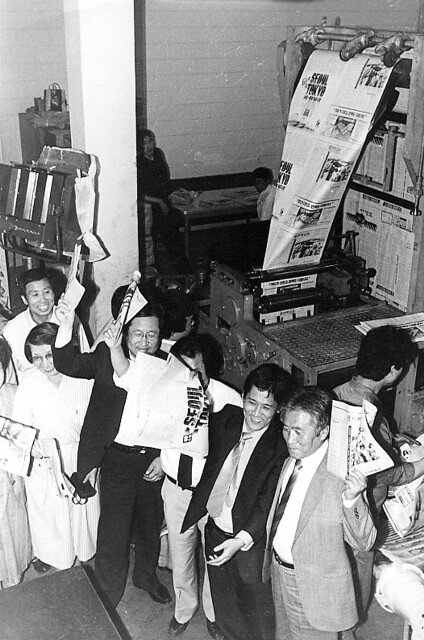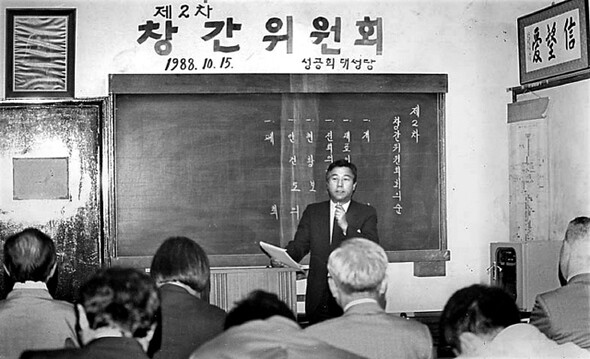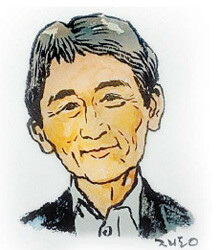hankyoreh
Links to other country sites 다른 나라 사이트 링크
[Memoir] The turbulent makings of an “essential” newspaper

By Sung Yu-bo, former Hankyoreh editor-in-chief
The Hankyoreh was launched on May 15, 1988. It was a new beacon of hope, a symbol of a more democratic future for many South Korean citizens who were panicking at the results of the December 1987 presidential election, with its victory for Roh Tae-woo - a friend of military regime leader Chun Doo-hwan and a key figure in the 1980 coup that put Chun into power - and defeat for the forces of democracy.
In his inaugural statement, the newspaper’s first president, the late Song Kun-ho, declared that the Hankyoreh would “work invariably to achieve democracy in this nation.”
“The democratization of this country is a necessary condition to improve relations between South and North, and in particular to end the military confrontation between the Korean People and achieve reunification,” he declared.
As the first editor-in-chief, I decided to print a powerful image to represent democracy and peaceful reunification: a large photograph of Lake Cheonji on Mt. Baekdu, with a caption reading, “Lake Cheonji: The end of yearning and the start of hope for 60 million.”
Funding was the biggest obstacle when we were preparing the launch in July 1987. Media observers at the time predicted that it would cost over 20 billion won (US$19.5 million today) to launch a national daily. But Jeong Tae-gi of the Chosun Ilbo Free Press Committee (a group of reporters who were dismissed by the Chosun Ilbo) said 5 billion won (US$4.9 million) would be enough. There had been a printing technology revolution, he argued, and the costs of editing, production, and printing had fallen dramatically. He convinced Song and a number of others, including Ri Young-hee, Lee Byeong-ju, and Kim Tae-hong (all of whom have since passed away) as well as Im Jae-kyung and Kwon Keun-sul; they in turn shared their idea for a new newspaper with a number of journalists who had been dismissed from their previous jobs. In late July, they embarked on their fund-raising campaign. A research committee was set up for the new newspaper, and the campaign to find founders began.
The following August 31, Jeong and Kwon stopped at a training center on the outskirts of Daejeon to visit a provisional general meeting for delegates of the People‘s Movement Coalition for Democracy and Reunification. There, they explained to delegates with the coalition and its member groups about the need for a new newspaper. That was where I made up my mind to return to journalism. That September, a total of 196 people submitted a motion for its foundation, most of them dismissed reporters, and on October 30 a founders’ meeting was held in the auditorium of the YWCA in Seoul’s Myeong-dong neighborhood, with 3,317 people in attendance from all over the country, representing every walk of life.
Finding the funding turned out not to be so easy. By December 16, the eve of the presidential election, a mere 1 billion won (US$977,000) had been raised. But after the election defeat, it took just two months, until February 25, 1988, to meet the first goal of 5 billion won. One particularly passionate contributor was Kang Jeong-mun, a former Dong-A Ilbo Free Press Committee who was a director at the advertising company Daehong Planning. Each day, he would basically clock out there and head straight to the Hankyoreh preparation committee, although he never did officially join the Hankyoreh, offering all of his help from outside. Later on, he would become an advertising star as CEO of Daehong, a leading advertising firm, before passing away in 1999 at the untimely age of 54. It was a truly sad loss.

[The ’87 Election Loss and a New Icon of Hope]
Miraculously, we had managed to secure the funds we needed to launch the newspaper. But those early operation funds quickly ran out. The branch offices and sales chapters were hemorrhaging money. Because the head office was also financially strapped, it had to set a high company payment rate, which the local bureaus and chapters bore the brunt of. In those early days, many people would run through their own nest eggs while heading up an office or chapter. I personally knew too many of them to count - Kim Ja-dong, Busan bureau chief Moon Jae-in, the mother of the late Song Kwang-young, Seok Kyu-gwan, and Lee Ju-hyeong, head of the Yeongdong bureau.
The financial problems continued. At root, they came down to one major problem: no advertising revenue. Then as now, South Korea’s advertising market was under the control of chaebol. When the Hankyoreh first appeared, its paid circulation rate was 400,000 copies, ranking it fourth after the Chosun Ilbo, Joong-Ang Ilbo, and Dong-A Ilbo newspapers, but the chaebol wouldn’t advertise in it. Their argument was, “Why should be give ammunition to the ‘enemy of the chaebol’?” There wasn’t much a corporate public relations officer or advertising firm could do. Our advertising department was working as hard and they could, and we were getting nowhere.
As a last resort, the Hankyoreh decided to launch a campaign to raise a second fund for development. In September 1988, the board of directors voted to approve a capital increase of 7 billion won (US$6.8 million). The early fund-raising numbers were not bad at all: 1 billion won in the first month, about 800 million won (US$782,000) in November, 600 million won (US$586,000) in December. But by the new year, the campaign had petered out completely.
“If we want to inject new momentum into our fund-raising campaign,” I finally proposed at the 36th board of directors’ meeting on January 17, 1989, “then we need to give the people a message of hope.” My idea was to start a special fund-raising committee to join our newspaper advertising campaign. The other directors figured that I must have had some kind of plan already in place, so they voted to put me in charge of the special committee. At the time, I had just lost to Jang Yun-hwan in the first direct election for editor-in-chief (just introduced the previous August) and was working as an editorial board member for agriculture.
Up until then, I had never had much of a concept of money. When I agreed to serve as committee chair, it was because I knew that if the Hankyoreh went under, all those dismissed reporters who had helped to launch it would go down in history as con men, rather than apostles for a new press in a new era.
Members of the Fundraising Committee: Anxiously Burning the Midnight OilAt the end of Jan. 1989, the Special Committee for Raising a Development Fund was established, with eight members on the committee, namely Hwang Yu-mi, Kim Seon-ju, Hong Su-won, Go Hui-beom, Yun Seok-in, Park Jun-cheol, Park Sang-jin, and I. In early Feb. 1989, the committee got to work on a campaign to raise money for a new fund.

The Fundraising Committee developed three strategies. First, the committee would print fundraising advertisements to offer a vision for the future development of the Hankyoreh. Second, committee members agreed to actively seek potential investors in the newspaper. As part of this, they would also hold an investment seminar for potential investors on the afternoon and evening of days when the advertisement ran in the paper. The third strategy was involving all of the Hankyoreh employees in the fundraising efforts. To achieve this, the committee agreed to provide employees with a commission if they succeeded in bringing in investors.
Not only was the fundraising campaign something extra, on top of our normal workload, but talking to someone about investing in the paper meant that we at the least had to treat them to some makgeolli (Korean rice beer). After some of the first people to succeed at fundraising used the commission they received to buy a round for their coworkers, the employee fundraising efforts took off instantly throughout the company. From the afternoon through the evening, the members of the fundraising committee traveled around the city for various appointments; in the morning, we spent hours debating what concept we should use for the next newspaper advertisement.
The text of the newspaper advertisements that ran from early Feb. to late May 1989, which changed every week or two, clearly show the great pains taken by the members of the fundraising committee.
“One day, your son will ask you, ‘Mom, what did YOU do when we were forging democracy?’”
“Don’t you want to see the 16-page daily Hankyoreh next year? We need a high-speed rotary press. ”
“Don’t you want to see the 16-page daily Hankyoreh next year? An office is required to install the rotary press.”
“The second step toward a big change…launching the development HQ for constructing the building where we will install our high-speed rotary press.”
“Are you just a spectator? From now on, you and I are the stars of this democratic society.”
“Why don’t you look at the global community from the perspective of the Hankyoreh?”
“Your active support is needed to open up the age of national independence and unification that is coming soon.”
“You can count on the Hankyoreh Newspaper to move toward the world, toward democratization and unification.”
“Invest in the Hankyoreh Newspaper: more than 10 billion won raised so far, with strong, profitable management. The deadline is May 15th.”
“The Hankyoreh does not tremble even though the storm rages! The Hankyoreh survives and stands strong no matter what oppression it faces. The Hankyoreh Newspaper is here for the Korean public, with 430,000 subscribers and 50,000 stockholders! Invest now. Small contributions make a big difference at the Hankyoreh Newspaper.”
Having surpassed its fundraising goals after numerous twists and turns, the Hankyoreh was able to issue a message of gratitude to the new stockholders and to the public under the name of President Song Kun-ho on May 21, 1989. In this manner, as of that January, the Hankyoreh’s total capital increased to 16.9 billion won. There was the 5 billion won of capital for the inaugural edition, the 2.4 billion won collected in the first round of fundraising, and, and the 9.5 billion won raised by the fundraising committee. As a result, the Hanyoreh was able to undertake a campaign to double its readership, to dispatch permanent correspondents in Washington D.C. and Tokyo, to purchase its own land and build a new office, and to introduce new rotary presses.
The most memorable thing that happened during the fundraiser was the arrest of editorial advisor Ri Young-hee for violating the National Security Law after he planned a reporting trip to North Korea. Ri had meant to visit the North in Jan. 1989, but he canceled the trip after Rev. Mun Ik-hwan visited the North first. Much later, on Apr. 15, Ri was finally arrested by the Roh Tae-woo administration.
Numerous Koreans took out ads in the Hankyoreh to encourage Ri and to protest his arrest and responded enthusiastically to the drive to raise money for the development fund. In the single week from Apr. 21 to Apr. 27, a total of 1.72 billion won was raised.
[“A Paper That Is Absolutely Essential”]
I guess I just have wanderlust. In Feb. 1991, I left the Hankyoreh. I had a lot of irons in the fire during the three years I spent at the paper beginning in Feb. 1988, serving as the first and fourth editor-in-chief, chair of the special committee for the Hankyoreh development fund, director in charge of maintenance, director in charge of advertisement as well as head of the advertisement department, and supervising director.
There were a number of reasons why I left the Hankyoreh at the end of my term as the fourth chair of the editorial committee. However, when I looked back after a period of 10 years, I came to the realization that I had become vain and elitist without even realizing it after becoming the first secretary-general for the Coalition for a Democratic Press in 1985 at the age of 42, becoming secretary general of the Democratic Unification Public Campaign Coalition, and twice serving as the chair of the Hankyoreh editorial committee. Since coming to this conclusion, my heart has always been with the Hankyoreh.

In four years, the Hankyoreh will mark the 30th anniversary of its inaugural issue. I am truly amazed at the persistence of the Hankyoreh, which has weathered all kinds of difficulties to remain with us today. But even so, I have one request to make to the Hankyoreh. In the future, I hope that it will continue to be, not a paper that is better than nothing, but a paper that is absolutely essential for democracy in Korea and for peace on the Korean peninsula.
Please direct questions or comments to [english@hani.co.kr]

Editorial・opinion
![[Column] Has Korea, too, crossed the Rubicon on China? [Column] Has Korea, too, crossed the Rubicon on China?](https://flexible.img.hani.co.kr/flexible/normal/500/300/imgdb/original/2024/0419/9317135153409185.jpg) [Column] Has Korea, too, crossed the Rubicon on China?
[Column] Has Korea, too, crossed the Rubicon on China?![[Correspondent’s column] In Japan’s alliance with US, echoes of its past alliances with UK [Correspondent’s column] In Japan’s alliance with US, echoes of its past alliances with UK](https://flexible.img.hani.co.kr/flexible/normal/500/300/imgdb/original/2024/0419/2317135166563519.jpg) [Correspondent’s column] In Japan’s alliance with US, echoes of its past alliances with UK
[Correspondent’s column] In Japan’s alliance with US, echoes of its past alliances with UK- [Editorial] Does Yoon think the Korean public is wrong?
- [Editorial] As it bolsters its alliance with US, Japan must be accountable for past
- [Guest essay] Amending the Constitution is Yoon’s key to leaving office in public’s good graces
- [Editorial] 10 years on, lessons of Sewol tragedy must never be forgotten
- [Column] A death blow to Korea’s prosecutor politics
- [Correspondent’s column] The US and the end of Japanese pacifism
- [Guest essay] How Korea turned its trainee doctors into monsters
- [Guest essay] As someone who helped forge Seoul-Moscow ties, their status today troubles me
Most viewed articles
- 1[Column] The clock is ticking for Korea’s first lady
- 2After 2 months of delayed, denied medical care, Koreans worry worst may be yet to come
- 3Hong Se-hwa, voice for tolerance whose memoir of exile touched a chord, dies at 76
- 4[Column] Has Korea, too, crossed the Rubicon on China?
- 5[Correspondent’s column] In Japan’s alliance with US, echoes of its past alliances with UK
- 6Samsung barricades office as unionized workers strike for better conditions
- 7All eyes on Xiaomi after it pulls off EV that Apple couldn’t
- 8[Editorial] As it bolsters its alliance with US, Japan must be accountable for past
- 9[News analysis] After elections, prosecutorial reform will likely make legislative agenda
- 10US overtakes China as Korea’s top export market, prompting trade sanction jitters